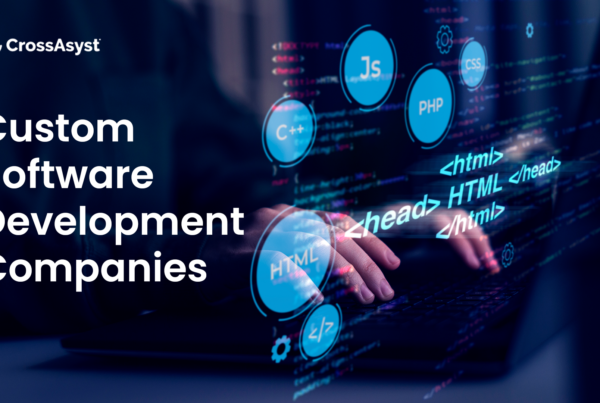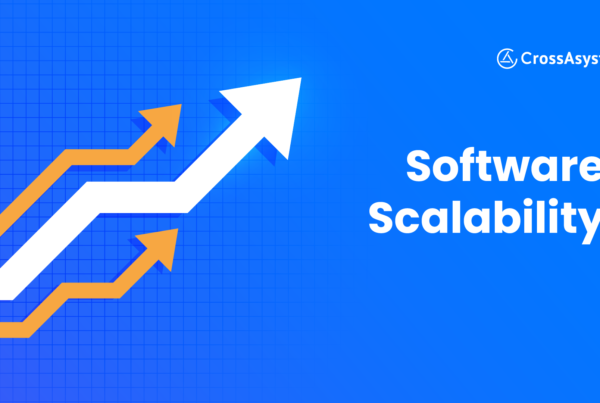As with most things, a one-size-fits-all approach does not work when it comes to custom software development. Different projects need a different approach, or software development methodology, each of which comes with its own set of pros and cons.
Here’s a quick overview of what software development methodologies are, why they are important, a look at some of the popular software development methodologies, and more.
Table of Contents
What are Software Development Methodologies?
Software Development Methodologies, or SDMs, are structured approaches to software development that guide the process from conception to delivery. These methodologies provide a framework for planning, structuring, and controlling the process of developing an information system.
Importance of Choosing a Software Development Methodology
Several factors influence the outcome of a software development project. Here are some of the reasons why it is important to choose a software development methodology.
Project Size and Complexity
The choice of an SDM is intrinsically tied to the intricacies of the project at hand. For larger projects with complex requirements, a methodology that emphasizes thorough planning and sequential progress, such as the Waterfall Development Methodology, might be preferable.
Team Expertise
The skill set of your development team is a pivotal factor. Agile methodologies, like Scrum or Extreme Programming, are well-suited for teams that thrive in dynamic, collaborative environments.
Stakeholder Involvement
The level of stakeholder involvement varies across methodologies. For projects where continuous feedback and adaptation are vital, Agile shines with its iterative approach that encourages frequent stakeholder input.
Project Requirements
Different projects have different needs. A project with changing requirements may benefit from an adaptive methodology like Lean Development or DevOps.
Organizational Culture
The culture within your organization can significantly impact the effectiveness of an SDM. Some methodologies, like Lean or Agile, foster a culture of collaboration and adaptability.
Top 5 Software Development Methodologies
Let’s now take a quick look at 5 software development methodologies.
 1. Waterfall Development Methodology
1. Waterfall Development Methodology
The Waterfall model is a linear and sequential approach, where progress flows steadily in one direction through phases like Conception, Initiation, Analysis, Design, Construction, Testing, Maintenance, and Conclusion.
Advantages
- Simple and easy to understand, making it ideal for novice developers.
- Clear structure and documentation.
- Well-suited for smaller projects with well-defined requirements.
Disadvantages
- Limited flexibility for changes after the project has started.
- Not ideal for projects that require constant maintenance.
- Limited options to make changes to the software once the project has been completed.
2. Agile Development Methodology
Agile is an iterative and flexible approach that emphasizes adaptability, collaboration, and customer satisfaction through continuous delivery.
Advantages
- Frequent client feedback.
- Quick adaptation to changes.
Disadvantages
- May lack structure for larger projects.
- Assessing effort is often difficult, especially at the beginning of the development cycle.
- More attention should be given to documentation.
3. Lean Development
Lean Development aims to maximize efficiency by eliminating waste and optimizing resources, focusing on continuous improvement.
Advantages
- Efficient resource utilization ensures cost efficiency in the development process.
- Rapid delivery ensures the development team does not spend too much time on one project…
Disadvantages
- It may not be suitable for projects requiring a structured approach.
- The overall quality of the output depends entirely on the skill levels and dedication of the development team members.
4. DevOps Methodology
DevOps combines development and operations, fostering collaboration and communication for efficient, continuous delivery.
Advantages
- Streamlined workflows ensure different aspects of the project are simultaneously developed.
- Faster time-to-market with minimal downtime, thanks to the use of CI/CD and scalable microservices.
- Encourages ownership, collaboration, and accountability from the development and operations teams.
Disadvantages
- Requires cultural and organizational shifts.
- Speed and security are often compromised.
5. Scrum Development Methodology
Scrum is an Agile framework that organizes work into fixed-length iterations called sprints, fostering collaboration and adaptability.
Advantages
- Increased productivity.
- Emphasis on continuous improvement.
- Ideal for fast-paced development and testing.
- Short sprints and continuous feedback make it easy to accept changes.
Disadvantages
- Can be challenging for larger teams.
- Scope creep is a definite risk.
- Requires all the development team members to be very experienced.
Difficulties in Implementing Software Development Methodologies
Implementing different software development methodologies comes with its risks and challenges. Let’s quickly take a look at some of these difficulties.
Resistance to Change
Change is often met with resistance, especially in well-established teams. Introducing a new methodology requires clear communication and education about the benefits.
Project Complexity
For complex projects, some methodologies might introduce additional steps that could feel like unnecessary work, impacting efficiency.
Ineffective Project Management
Inconsistent team dynamics, poor communication, unclear objectives, and changing requirements midway can contribute to ineffective project management.
Inconsistent Team Dynamics
Team coordination is vital. Methodologies that promote collaboration, such as Agile or Scrum, can address challenges related to inconsistent team dynamics.
Project Size
Choosing a methodology that aligns with the size of the project is crucial. Smaller projects may benefit from more flexible approaches, while larger projects might require a more structured framework.
Poor Communication
Effective communication is essential for successful development. Methodologies like DevOps prioritize communication and collaboration between development and operations teams.
Unclear Objectives and Requirements
Changing requirements midway through a project can lead to confusion. Choosing a methodology that accommodates changes, like Agile or Lean, can mitigate this challenge.
Time Consumption
Some methodologies, such as Waterfall, may be perceived as time-consuming due to their sequential nature. Assessing project timelines and choosing an appropriate methodology is key.
Resource Allocation
Inadequate allocation of resources can hinder progress. Lean methodologies, with their focus on efficient resource utilization, can mitigate resource-related challenges.
Insufficient Training and Skill Sets
Adopting a new methodology requires training and skill development. Ensuring that the team is adequately trained and possesses the necessary skills is crucial.
Risk Mitigation
Addressing risks early in the development process is vital. Methodologies like the Spiral Model explicitly focus on risk analysis and mitigation.
Tools and Technology
The choice of tools and technology can impact the success of an SDM. Some methodologies, like DevOps, prioritize streamlined workflows and the integration of cutting-edge technologies.
Cultural Transformation
Certain methodologies, like Agile or DevOps, may require a cultural shift within the organization. Recognizing and addressing cultural aspects is essential for successful implementation.
Budget
Budget constraints play a significant role in methodology selection. Understanding the financial limitations and choosing a methodology that aligns with the available budget is crucial.
How to Adopt the Right Software Development Methodology
So should you go about choosing the right software development methodology? Here are some of the factors that you ought to consider.
Understand Project Requirements
Clearly defining project requirements is the first step. Waterfall may suit well-defined, stable requirements, while Agile allows for flexibility and adaptation.
Consider Project Size and Complexity
For large, complex projects, methodologies like the Spiral Model or DSDM that address risks and allow for iterative development may be preferable.
Assess Project Flexibility Requirements
Projects with evolving requirements may benefit from Agile or Lean methodologies, allowing for continuous adaptation.
Evaluate Project Timeline
Projects with tight timelines may find success with Agile or RAD, which emphasize quick iterations and rapid development.
Analyze Team Size and Expertise
The size and expertise of your team influence the choice of methodology. Scrum and Extreme Programming are well-suited for smaller, highly skilled teams.
Assess Risks Tolerance
Understanding your organization’s tolerance for risks is crucial. The Spiral Model explicitly addresses risks early in the development process.
Understand Client and Stakeholder Involvement
For projects requiring frequent client and stakeholder involvement, Agile and Scrum excel with their iterative approach and emphasis on collaboration.
Review Organizational Culture
Choosing a methodology that aligns with your organizational culture is essential. For a collaborative and adaptive culture, Agile or Lean may be suitable.
Evaluate Budget Constraints
Budget constraints are a reality for many projects. Choosing a methodology that aligns with the available budget, such as Lean or Agile, is imperative.
Consider Past Project Successes and Failures
Learning from past experiences is invaluable. Reflecting on past successes and failures can guide the choice of an appropriate methodology.
Seek Input from the Development Team
Involving the development team in the decision-making process ensures that the chosen methodology aligns with their skills and preferences.
Tailor the Methodology
No methodology is one-size-fits-all. Tailoring the chosen methodology to suit the specific needs and nuances of the project is a key aspect of successful implementation.
Leverage the Best Development Methodologies With CrossAsyst
Let’s reiterate one fact: a one-size-fits-all approach to software development does not work. Different clients have different needs, and this means custom software developers ought to be able to adopt different methodologies to address those needs.
With more than a decade of experience in custom software development across multiple business verticals, we at CrossAsyst understand this perfectly and have the expertise to deliver exactly what our clients need. Our software teams are well-versed in multiple software development methodologies, including Waterfall, Agile, Scrum, and more.
Our development teams often use multiple software development methodologies simultaneously for the best results, such as Agile-Scrum, Agile-Kanban, and when the need arises, even Agile-Scrum and Waterfall.
When you partner with CrossAsyst for your custom software development needs, you can rest assured that we will use the best development methodologies, innovations, and all of our experience to ensure your new software is stable, technologically superior, and hits the market on time, if not earlier.
Book a consultation with our team today, and discover why CrossAsyst is a global leader in custom software development.




